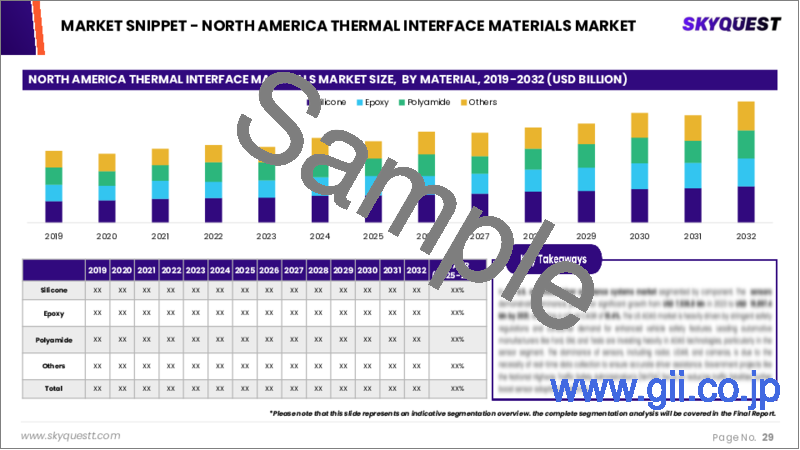|
|
市場調査レポート
商品コード
1544180
TIM(サーマルインターフェースマテリアル)の市場規模、シェア、成長分析:材料別、用途別、化学物質別、地域別 - 産業予測、2024-2031年Thermal Interface Materials Market Size, Share, Growth Analysis, By Material, By Application, By Chemistry, By Region - Industry Forecast 2024-2031 |
||||||
|
|||||||
| TIM(サーマルインターフェースマテリアル)の市場規模、シェア、成長分析:材料別、用途別、化学物質別、地域別 - 産業予測、2024-2031年 |
|
出版日: 2024年08月23日
発行: SkyQuest
ページ情報: 英文 184 Pages
納期: 3~5営業日
|
- 全表示
- 概要
- 目次
TIM(サーマルインターフェースマテリアル)の世界市場規模は2022年に37億5,000万米ドルとなり、2023年の41億3,000万米ドルから2031年には89億9,000万米ドルに達し、予測期間(2024-2031年)のCAGRで10.2%の成長が予測されています。
TIMの世界市場は、電子機器から発生する熱を管理するという重要な役割によって急速に拡大しています。より小さく、より強力で、エネルギー効率に優れた電子部品への需要が高まるにつれ、効果的な熱管理の必要性がますます高まっています。TIMは、発熱部品とヒートシンク間のギャップを埋め、接触抵抗を低減することで、効率的な熱伝達を確保し、過熱を防止するために不可欠です。市場の成長には、自動車、コンシューマーエレクトロニクス、航空宇宙、通信などさまざまな分野で電子機器の採用が増加していることが寄与しており、これらすべての分野で効率的な熱管理ソリューションが必要とされています。電子機器の小型化と回路の複雑化の動向は、最適な性能と寿命を維持するための高度な熱管理の必要性をさらに高めています。さらに、エネルギー効率と環境の持続可能性に焦点を当てた厳しい規制が、メーカーに放熱を強化するTIMの採用を促し、エネルギー消費と二酸化炭素排出を削減しています。こうした成長機会にもかかわらず、市場は課題にも直面しています。先進的なTIMの高コストと、その応用や設置に伴う複雑さが市場拡大の妨げになる可能性があります。さらに、電子機器の絶え間ない進化により、新材料や新技術との互換性を確保するためにTIMの継続的な技術革新が必要となっています。TIM市場の主な動向には、相変化材料、グラファイトベースのソリューション、優れた熱伝導性と信頼性を提供する液体金属TIMなどの先端材料へのシフトが含まれます。5G、IoT、電気自動車などの新興技術へのTIMの統合も大きな成長機会をもたらします。自動車産業の電動化、再生可能エネルギー源の重視、ナノテクノロジーの進歩は、市場の可能性をさらに高め、ダイナミックで有望な分野となっています。
目次
イントロダクション
- 調査の目的
- 定義
- 市場範囲
調査手法
- 情報調達
- 二次データソースと一次データソース
- 市場規模予測
- 市場の想定と制限
エグゼクティブサマリー
- 市場概要見通し
- 供給需要動向分析
- セグメント別機会分析
市場力学と見通し
- 市場力学
- 促進要因
- 機会
- 抑制要因
- 課題
- ポーターの分析
主な市場の考察
- 市場の成功要因
- 競合の程度
- 主な投資機会
- 市場魅力度指数
- エコシステムマッピング
- 市場需要分析
- 材料と技術の分析
- 費用便益分析
- 競合情勢分析
- 将来展望分析
- 市場セグメンテーション・ターゲティング分析
TIM市場:材料別
- 市場概要
- グリース・接着剤
- テープ・フィルム
- ギャップフィラー
- 金属ベースTIM
- 相変化物質
- その他
TIM市場:用途別
- 市場概要
- コンピューター
- 通信
- 医療機器
- 産業機械
- 耐久消費財
- 自動車用エレクトロニクス
- その他
TIM市場:化学物質別
- 市場概要
- シリコーン
- エポキシ
- ポリアミド
- その他
TIM市場規模:地域別
- 市場概要
- 北米
- 米国
- カナダ
- 欧州
- ドイツ
- 英国
- フランス
- イタリア
- スペイン
- その他欧州地域
- アジア太平洋地域
- 中国
- インド
- 日本
- 韓国
- その他アジア太平洋地域
- ラテンアメリカ
- ブラジル
- その他ラテンアメリカ地域
- 中東・アフリカ(MEA)
- GCC諸国
- 南アフリカ
- その他中東・アフリカ地域
競合情勢
- 上位5社の比較
- 主要企業の市場ポジショニング(2023年)
- 主な市場企業が採用した戦略
- 市場における最近の活動
- 主要企業の市場シェア(2023年)
主要企業プロファイル
- Henkel AG & Co. KGaA(Germany)
- Dow Inc.(US)
- 3M Company(US)
- Parker-Hannifin Corporation(US)
- Honeywell International Inc.(US)
- Momentive Performance Materials Inc.(US)
- Fujipoly(Japan)
- Shin-Etsu Chemical Co., Ltd.(Japan)
- Indium Corporation(US)
- Zalman Tech Co., Ltd.(South Korea)
- SEMIKRON International GmbH(Germany)
- Avery Dennison Corporation(US)
- AOS Thermal Compounds LLC(US)
- Enerdyne Solutions(US)
- Electrolube(UK)
- Polytec PT GmbH(Germany)
- Arctic Cooling(Switzerland)
- Thermal Grizzly(Germany)
- Gelid Solutions Ltd.(Hong Kong)
- Nanografi(Turkey)
- ProTek Devices(US)
- Silicone Solutions(US)
Global Thermal Interface Materials Market size was valued at USD 3.75 Billion in 2022 and is poised to grow from USD 4.13 Billion in 2023 to USD 8.99 Billion by 2031, at a CAGR of 10.2% during the forecast period (2024-2031).
The Global Thermal Interface Materials (TIM) Market is rapidly expanding, driven by its critical role in managing the heat generated by electronic devices. As the demand for smaller, more powerful, and energy-efficient electronic components grows, the need for effective thermal management becomes increasingly important. TIMs are essential in filling gaps and reducing contact resistance between heat-generating components and heat sinks, ensuring efficient heat transfer and preventing overheating. The market's growth is fueled by the rising adoption of electronic devices across various sectors such as automotive, consumer electronics, aerospace, and telecommunications, all of which require efficient heat management solutions. The trend toward miniaturization and increased circuit complexity in electronics further heightens the need for advanced thermal management to maintain optimal performance and longevity. Additionally, stringent regulations focused on energy efficiency and environmental sustainability are pushing manufacturers to adopt TIMs that enhance heat dissipation, thereby reducing energy consumption and carbon emissions. Despite these growth opportunities, the market faces challenges. The high cost of advanced thermal interface materials and the complexities involved in their application and installation can hinder market expansion. Furthermore, the continuous evolution of electronic devices necessitates ongoing innovation in TIMs to ensure compatibility with new materials and technologies. Key trends in the TIM market include the shift towards advanced materials such as phase change materials, graphite-based solutions, and liquid metal TIMs, which offer superior thermal conductivity and reliability. The integration of TIMs into emerging technologies like 5G, IoT, and electric vehicles also presents significant growth opportunities. The electrification of the automotive industry, the focus on renewable energy sources, and advancements in nanotechnology further contribute to the market's potential, making it a dynamic and promising sector.
Top-down and bottom-up approaches were used to estimate and validate the size of the Global Thermal Interface Materials market and to estimate the size of various other dependent submarkets. The research methodology used to estimate the market size includes the following details: The key players in the market were identified through secondary research, and their market shares in the respective regions were determined through primary and secondary research. This entire procedure includes the study of the annual and financial reports of the top market players and extensive interviews for key insights from industry leaders such as CEOs, VPs, directors, and marketing executives. All percentage shares split, and breakdowns were determined using secondary sources and verified through Primary sources. All possible parameters that affect the markets covered in this research study have been accounted for, viewed in extensive detail, verified through primary research, and analyzed to get the final quantitative and qualitative data.
Global Thermal Interface Materials Market Segmental Analysis
Global Thermal Interface Materials Market is segmented on the basis of chemistry, material, application, and region. Based on Chemistry, the market is segmented into silicone, epoxy, polyamide, others. Based on Material, the market is segmented into greases and adhesive, tapes and films, gap fillers, metal-based thermal interface material, phase change material, and others. Based on application, the market is segmented into computer, telecom, medical devices, industrial machinery, consumer durables, automotive electronics, others. Based on region, the market is segmented into North America, Europe, Asia Pacific, Middle East and Africa, and Latin America.
Drivers of the Global Thermal Interface Materials Market
The increasing popularity of smartphones, laptops, gaming consoles, and other electronic devices is creating a heightened need for effective thermal management solutions. Thermal Interface Materials (TIMs) play a crucial role in dissipating the heat produced by these devices, preventing overheating, and maintaining optimal performance. For instance, the surge in gaming enthusiasts has significantly boosted the demand for high-performance computers, which rely on advanced thermal management to ensure they operate efficiently and safely.
Restraints in the Global Thermal Interface Materials Market
Although there are numerous types of Thermal Interface Materials (TIMs) with varying thermal conductivity properties, some may fall short in delivering optimal heat transfer. Certain TIMs may not provide high enough thermal conductivity, which can limit their effectiveness in applications with demanding heat dissipation requirements. Ongoing research and development are concentrated on creating new TIM formulations that offer enhanced thermal conductivity to address these limitations and improve performance in critical applications.
Market Trends of the Global Thermal Interface Materials Market
Phase Change Materials (PCMs) are a category of Thermal Interface Materials (TIMs) that undergo phase transitions-such as from solid to liquid or vice versa-when exposed to temperature fluctuations. These materials exhibit high thermal conductivity during these transitions, which makes them highly effective for managing heat. PCMs are increasingly being utilized in applications where efficient heat dissipation is crucial, such as in data centers and electric vehicle batteries. Their ability to absorb and release heat during phase changes enhances their performance in maintaining optimal temperatures in high-demand environments.
Table of Contents
Introduction
- Objectives of the Study
- Definitions
- Market Scope
Research Methodology
- Information Procurement
- Secondary & Primary Data Sources
- Market Size Estimation
- Market Assumptions & Limitations
Executive Summary
- Market Overview Outlook
- Supply Demand Trend Analysis
- Segmental Opportunity Analysis
Market Dynamics & Outlook
- Market Dynamics
- Drivers
- Opportunities
- Restraints
- Challenges
- Porters Analysis
- Competitive rivalry
- Threat of Substitute Products
- Bargaining Power of Buyers
- Threat of New Entrants
- Bargaining Power of Suppliers
Key Market Insights
- Key Success Factors of The Market
- Degree Of Competition
- Top Investment Pockets
- Market Attractive Index
- Ecosystem Mapping
- Market demand analysis
- Material and Technology Analysis
- Cost Benefit Analysis
- Competitive Landscape Analysis
- Future Outlook Analysis
- Market Segmentation and Targeting Analysis
Global Thermal Interface Materials Market by Material
- Market Overview
- Greases and Adhesive
- Tapes and Films
- Gap Fillers
- Metal-Based Thermal Interface Material
- Phase Change Material
- Others
Global Thermal Interface Materials Market by Application
- Market Overview
- Computer
- Telecom
- Medical Devices
- Industrial Machinery
- Consumer Durables
- Automotive Electronics
- Others
Global Thermal Interface Materials Market by Chemistry
- Market Overview
- Silicone
- Epoxy
- Polyamide
- Others
Global Thermal Interface Materials Market Size by Region
- Market Overview
- North America
- USA
- Canada
- Europe
- Germany
- UK
- France
- Italy
- Spain
- Rest of Europe
- Asia Pacific
- China
- India
- Japan
- South Korea
- Rest of Asia-Pacific
- Latin America
- Brazil
- Rest of Latin America
- Middle East & Africa (MEA)
- GCC Countries
- South Africa
- Rest of MEA
Competitive Landscape
- Top 5 Player Comparison
- Market Positioning of Key Players, 2023
- Strategies Adopted by Key Market Players
- Recent Activities in the Market
- Key Companies Market Share (%), 2023
Key Company Profiles
- Henkel AG & Co. KGaA (Germany)
- Company Overview
- Business Segment Overview
- Financial Updates
- Key Developments
- Dow Inc. (US)
- Company Overview
- Business Segment Overview
- Financial Updates
- Key Developments
- 3M Company (US)
- Company Overview
- Business Segment Overview
- Financial Updates
- Key Developments
- Parker-Hannifin Corporation (US)
- Company Overview
- Business Segment Overview
- Financial Updates
- Key Developments
- Honeywell International Inc. (US)
- Company Overview
- Business Segment Overview
- Financial Updates
- Key Developments
- Momentive Performance Materials Inc. (US)
- Company Overview
- Business Segment Overview
- Financial Updates
- Key Developments
- Fujipoly (Japan)
- Company Overview
- Business Segment Overview
- Financial Updates
- Key Developments
- Shin-Etsu Chemical Co., Ltd. (Japan)
- Company Overview
- Business Segment Overview
- Financial Updates
- Key Developments
- Indium Corporation (US)
- Company Overview
- Business Segment Overview
- Financial Updates
- Key Developments
- Zalman Tech Co., Ltd. (South Korea)
- Company Overview
- Business Segment Overview
- Financial Updates
- Key Developments
- SEMIKRON International GmbH (Germany)
- Company Overview
- Business Segment Overview
- Financial Updates
- Key Developments
- Avery Dennison Corporation (US)
- Company Overview
- Business Segment Overview
- Financial Updates
- Key Developments
- AOS Thermal Compounds LLC (US)
- Company Overview
- Business Segment Overview
- Financial Updates
- Key Developments
- Enerdyne Solutions (US)
- Company Overview
- Business Segment Overview
- Financial Updates
- Key Developments
- Electrolube (UK)
- Company Overview
- Business Segment Overview
- Financial Updates
- Key Developments
- Polytec PT GmbH (Germany)
- Company Overview
- Business Segment Overview
- Financial Updates
- Key Developments
- Arctic Cooling (Switzerland)
- Company Overview
- Business Segment Overview
- Financial Updates
- Key Developments
- Thermal Grizzly (Germany)
- Company Overview
- Business Segment Overview
- Financial Updates
- Key Developments
- Gelid Solutions Ltd. (Hong Kong)
- Company Overview
- Business Segment Overview
- Financial Updates
- Key Developments
- Nanografi (Turkey)
- Company Overview
- Business Segment Overview
- Financial Updates
- Key Developments
- ProTek Devices (US)
- Company Overview
- Business Segment Overview
- Financial Updates
- Key Developments
- Silicone Solutions (US)
- Company Overview
- Business Segment Overview
- Financial Updates
- Key Developments





